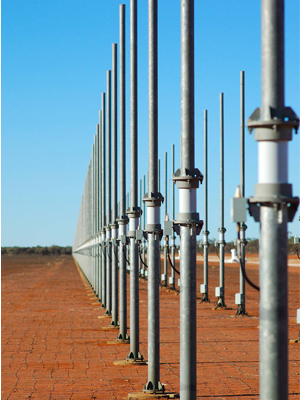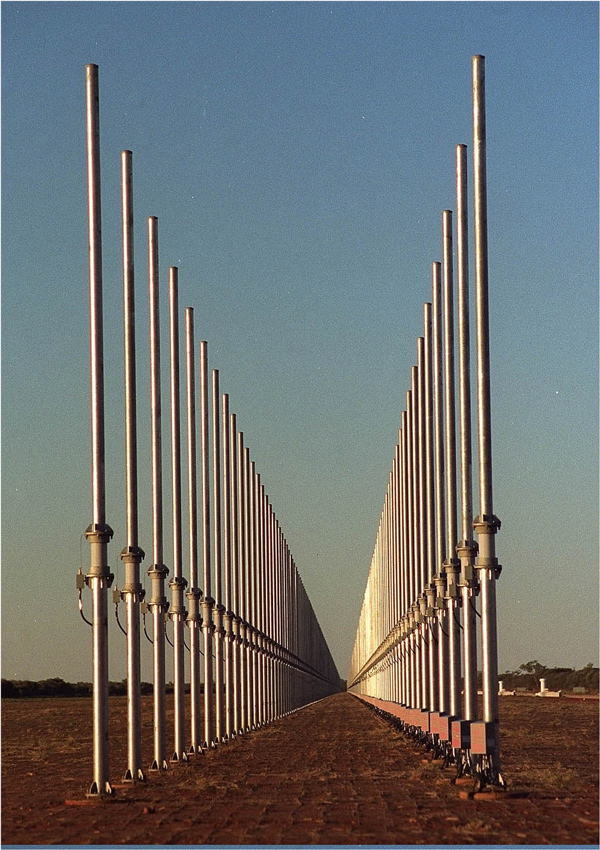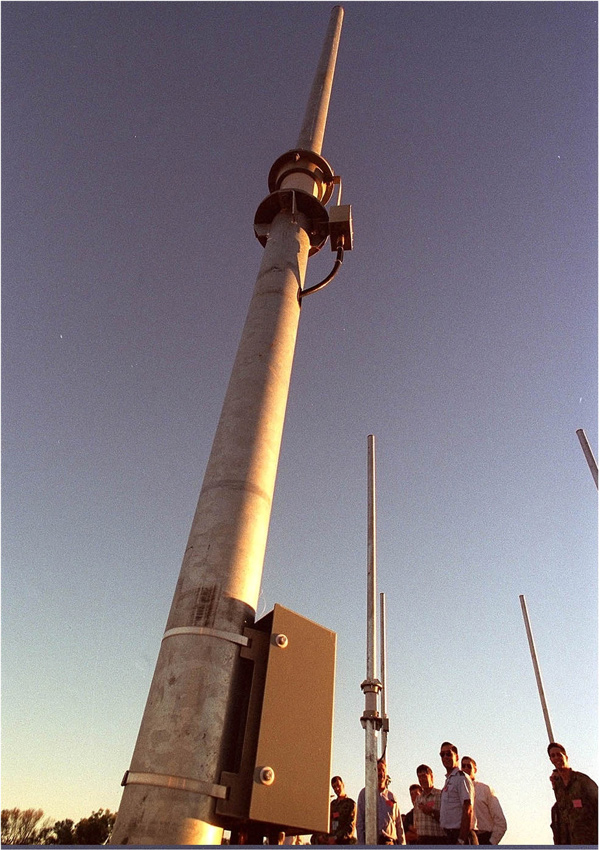Jindalee Operational Radar Network

Australia is the world leader in high-frequency, skywave over-the-horizon radar (OTHR) technology.
The state-of-the-art defence system provides wide-area surveillance at ranges of 1,000 to 3,000 kilometres and plays a vital role in supporting the Australian Defence Force's air and maritime operations, border protection, disaster relief and rescue operations.
JORN works by refracting high-frequency electromagnetic waves off the ionosphere to 'see' objects thousands of kilometres away that are invisible to conventional radars because of the curvature of the earth.
It is controlled and operated by the Royal Australian Air Force (RAAF) from the Battlespace Surveillance Centre at its Edinburgh base in South Australia.
The technology had its beginnings in early research into the ionosphere conducted at Weapons Research Establishment from the 1950s. Subsequently, the Jindalee high frequency OTHR became a core research project from 1970 and was developed to provide surveillance across Australia's northern sea and air approaches.
Unlike traditional radars that were limited by the line of sight, the Jindalee high frequency OTHR conceived and designed by Australian scientists used the ionosphere above the earth's surface. A high frequency radio signal was beamed skywards from a transmitter and refracted down from the ionosphere to illuminate a target. The echo from the target travelled by a similar path back to a separate receiver site. Received data was processed into real-time tracking information.
Developing Jindalee from 'concept demonstrator' phase to proven operational capability continued from 1971 to 1987. It is an outstanding example of collaboration with partners in defence, Government, academia and defence industry.
In 2003, JORN was commissioned, delivering a further two radars to the ADF, in addition to the original Jindalee facility in Alice Springs. Since then, JORN has undergone a number of upgrades, with BAE Systems Australia leading the Phase 6 $1.2 billion upgrade with more than 110 Australian suppliers, including indigenous suppliers and local small to medium enterprises involved. BAE has supported the acquisition and sustainment of Jindalee and JORN since the 1980s and provides deeper maintenance for the majority of JORN network hardware.
Initial development
Developing Jindalee from 'concept demonstrator' phase to proven operational capability occurred from 1971 to 1987. In 1971, DSTO Senior Principal Research Scientist John Strath advocated strongly and successfully for the funding of a scaled-up OTHR prototype. The first experimental radar, designed and built by DSTO (now Defence Science and Technology Group), was constructed at Alice Springs in central Australia in the mid-1970s. It later became known as the 'Stage A' evaluation program.
Jindalee 'A' was modestly powered and had a narrow field of detection, a 'staring' beam, with a simple whip-antenna array only one-quarter the length of the current Alice Springs Jindalee radar (2.8 km). But Jindalee 'A' did detect aircraft at long ranges and, later, ships. Its radar waveform generator was one of the few pieces of Australian-developed 'original equipment' retained in later Jindalee stages.
In the early 1980s, Jindalee 'B', costing some $30 million, was developed. It was higher-powered, covered at least sixty degrees, had radar track-while-scan capability and an advanced automatic frequency allocation system. It also had an ARO multi-port computer processor — designed in-house and central to supporting radar signal processing. The decision to acquire JORN as a Defence asset began in February 1985 when the Minister for Defence, Kim Beazley, commissioned Paul Dibb, who was an external consultant and former member of the Department of Defence, to analyse Australia's defence planning and make recommendations for future developments. Dibb's report was published in March 1986 and recommended that Australia abandon the remaining elements of the forward defence policy and concentrate its military resources on the geographic areas relevant to defending the country and its economic interests from direct attack. Dibb recommended that Australia's military posture be based on a strategy of denying aggressors the ability to attack the country. This was to be achieved through using a layered defence of over-the-horizon radar, patrol aircraft and maritime strike aircraft to protect Australia's approaches.
Dibb's recommendation to invest in OTHR research and acquire an operational system was adopted in the 1987 Department of Defence White Paper, 'The Defence of Australia', which stated that 'the Government has given high priority to the design and development of this [OTHR] network, based on the Australian designed Jindalee experimental radar. The OTHR network will be a basic element of a national system for air defence and airspace control.' The paper identified the Government's intention to acquire three OTHRs.
Based on the 1987 Defence White Paper, a joint project was initiated to build a further two OTHRs in addition to the experimental OTHR at Alice Springs.
In 1986, approval was given for the design and development of the OTHR network. This was followed in March 1987 when the federal government launched its Policy Information Paper — The Defence of Australia 1987 — which placed a high priority on establishing a network of OTHRs. It was envisaged that a network of up to three OTHR installations would be constructed covering the approaches of northern Australia.
That same year, the operational radar Jindalee 'C' was handed over to the Royal Australian Air Force (RAAF). This was achieved at an additional cost of $70 million with the earlier stage re-engineered by BAE Systems (formerly AWA) for the rugged demands of operational life.
In 1991, the Commonwealth awarded Telstra (previously Telecom) a prime contract worth $860 million to design and construct the Jindalee Operational Radar Network (JORN). The contract required Australian production of more than 70 per cent of the contract value.
Telstra awarded major sub-contracts to GEC Marconi and Telstar Systems, a joint venture between Telstra and Lockheed Martin Corporation. Other significant sub-contracts were awarded to Radio Frequency Systems, Compaq, Eckert Management Group, Fletcher Constructions and the John Holland Construction Group.
RLM Management Company, a joint venture of Lockheed Martin and the Tenix Group assumed full management responsibility for the JORN project in 1997.
In 1999, the contract to provide JORN to the Commonwealth was novated from Telstra to RLM, while No 1 Radar Surveillance Unit moved from Alice Springs to RAAF Base Edinburgh to remotely operate the Alice Springs OTHR from the Battlespace Surveillance Centre (previously JORN Coordination Centre).

One end of the 3.2km arrays of dipole antennae at the JORN Longreach receiver.
22 - 24JUN99 Photo LAC M Probert

The JORN Longreach dipole antenna array at dawn.
22 - 24JUN99 Photo LAC M Probert
JORN Phases 3-5 Upgrade
Phases 3 and 4 of the fully-fledged Defence network were operationally released to the RAAF and formally accepted in 2003. The domain knowledge within DSTG was critical in the design, execution and assessment of the intensive testing analysis that was carried out before the formal acceptance.
By this time, the new JORN capability consisted of two radars: Radar 1 located in Queensland and Radar 2 located in Western Australia. The original Jindalee radar at Alice Springs continued to be operated as a separate system by the RAAF. Throughout the life of Joint Project 2025 (JP2025) a number of incremental capability enhancements to the JORN radars have occurred. The JORN Phase 5 capability upgrade, concluding in 2013, integrated improvements developed by DSTG for the Alice Spring OTHR between 2003 and 2007 into the JORN radars. Furthermore, the Alice Springs radar was fully integrated into JORN under the Phase 5 project and is now designated as Radar 3. It is used synonymously by 1RSU with the other 2 radars and controlled from an integrated user interface.
JORN Phase 6 Upgrade
Since 2018, JORN has been undergoing a 10-year long comprehensive midlife redesign and upgrade – with BAE Systems Australia leading the upgrade - which aims to extend the capability life beyond 2040.
New radar sensor hardware designs and signal processing algorithms developed by DSTG will be incorporated to provide world-leading performance. A new open software architecture and modern user interface will be implemented to provide flexibility and enable efficient future enhancement.
Future prospects
DSTG continues to undertake research and development aimed at enhancing JORN's coverage, sensitivity and performance, as well as experimenting with new HF radar designs to address future ADF needs. As announced in the 2020 Defence Strategic Update, the Australian Government is considering the possibility of expanding JORN to provide wide area surveillance of Australia's eastern approaches. Furthermore, countries such as Canada are looking at partnering with Australia to build their own OTHR capabilities based on world-leading JORN technology.
Awards
1979 – Member of the Order of Australia
Mr J.A.W. Strath
For public service to defence science.
1989 – Minister’s Award
Dr Fred Earl
For his work on the Jindalee over-the-horizon radar.
1989 – CSIRO Gold Medal (for non-CSIRO work)
Jindalee team
For outstanding contribution to science.
1992 – Minister’s Award
Dr Stuart Anderson
For his contribution to the Jindalee over-the-horizon radar, particularly its ocean surveillance and meteorological capabilities.
1989 – Secretary of Defence Award
Dr Malcom Golley
For his role as a fundamental player in the development of Jindalee to operational capability.
2001 – Centenary Medal
Mr J.A.W. Strath
For service to Australian society in defence science.
2005 – Secretary of Defence Award
Paul Amey
For his exceptional contribution in the transitioning of the Jindalee radar capability into the broader Jindalee Operational Radar Network (JORN) system.
2009 – Minister's Award
Dr Gordon Frazer
For his internationally recognised expertise and inspirational leadership in advancing both Australian and Allied capabilities in Over the Horizon Radar.
2012 – Certificates of appreciation
JORN team
Recognised by then Minister for Defence Science and Personnel, Warren Snowdon.

